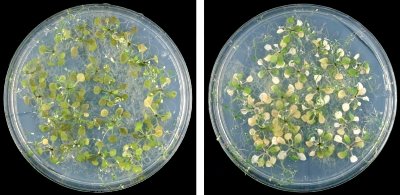Jul. 19, 2013 Research Highlight Biology
A new tool for engineering crop tolerance
Tolerance of phosphorus limitation in plants is linked to a previously unidentified lipid family
 Figure 1: Wild-type (left) and mutant (right) Arabidopsis plants grown under phosphorus-limited (P-limited) conditions. © 2013 Kazuki Saito, RIKEN Center for Sustainable Resource Science
Figure 1: Wild-type (left) and mutant (right) Arabidopsis plants grown under phosphorus-limited (P-limited) conditions. © 2013 Kazuki Saito, RIKEN Center for Sustainable Resource Science
Phosphorus (P) is one of three major nutrients required by plants but is lacking on approximately 40% of the world’s arable land. Understanding the mechanisms that plants have evolved to cope with P-limitation could therefore facilitate the engineering of P-limitation tolerant crops. Kazuki Saito, Yozo Okazaki and colleagues from the RIKEN Center for Sustainable Resource Science and other institutions in Japan have now identified a new class of plant lipid that is essential for P-limitation tolerance1.
Phosphorus-rich phospholipids are the primary component of plant cellular membranes, and plants can mobilize P during times of scarcity by replacing phospholipids with non-P glycerolipids. However, little was known about these non-P glycerolipids due to difficulties in differentiating and characterizing plant lipids, which comprise hundreds of molecules yet are distinguishable only through slight differences in structure.
Saito’s team used a novel mass spectrometry technique they developed previously for untargeted lipid profiling to produce distinctive molecular signatures that could be used for identification. Lipid profiles obtained for the model plant Arabidopsis grown under both P-limited and P-sufficient conditions revealed that the membranes of P-limited plants contained fewer phospholipids and more non-P glycerolipids. Most interestingly, the analysis revealed a previously unknown lipid, UK1.
The mass spectrum data of UK1 matched the signature of GlcADG, a known fungal and bacterial lipid. The researchers could also show that the fatty acid portion of GlcADG is almost identical to that of SQDG, a non-P lipid, suggesting that both are partially produced by the same biochemical pathway.
To determine the function of GlcADG, Saito’s team grew mutant and wild-type Arabidopsis plants in P-limited conditions. They found that mutants lacking both GlcADG and SQDG were severely damaged, displaying bleached leaves and reduced chlorophyll content (Fig. 1). However, plants that could produce at least one non-P glycerolipid—GlcADG—were healthy.
“Under P-limited conditions, membrane composition drastically changes to mobilize phosphorus, but membranes must still provide a suitable biochemical environment for essential enzymes,” explains Okazaki. GlcADG thus appears to aid in tuning the low-P membrane environment for enzyme function.
Saito’s team now plans to explore the pathways that produce GlcADG’s basic components. “Understanding this mechanism would make it feasible to engineer the tolerance of plants against a low-phosphorus environment,” says Saito. Given the finite global resources available for phosphorus fertilizers, P-limitation tolerant plants could be vitally important for future agriculture.
References
- 1. Okazaki, Y., Otsuki, H., Narisawa, T., Kobayashi, M., Sawai, S., Kamide, Y., Kusano, M., Aoki, T., Hirai, M. Y., & Saito, K. A new class of plant lipid is essential for protection against phosphorus depletion. Nature Communications 4, 1510 (2013). doi: 10.1038/ncomms2512
